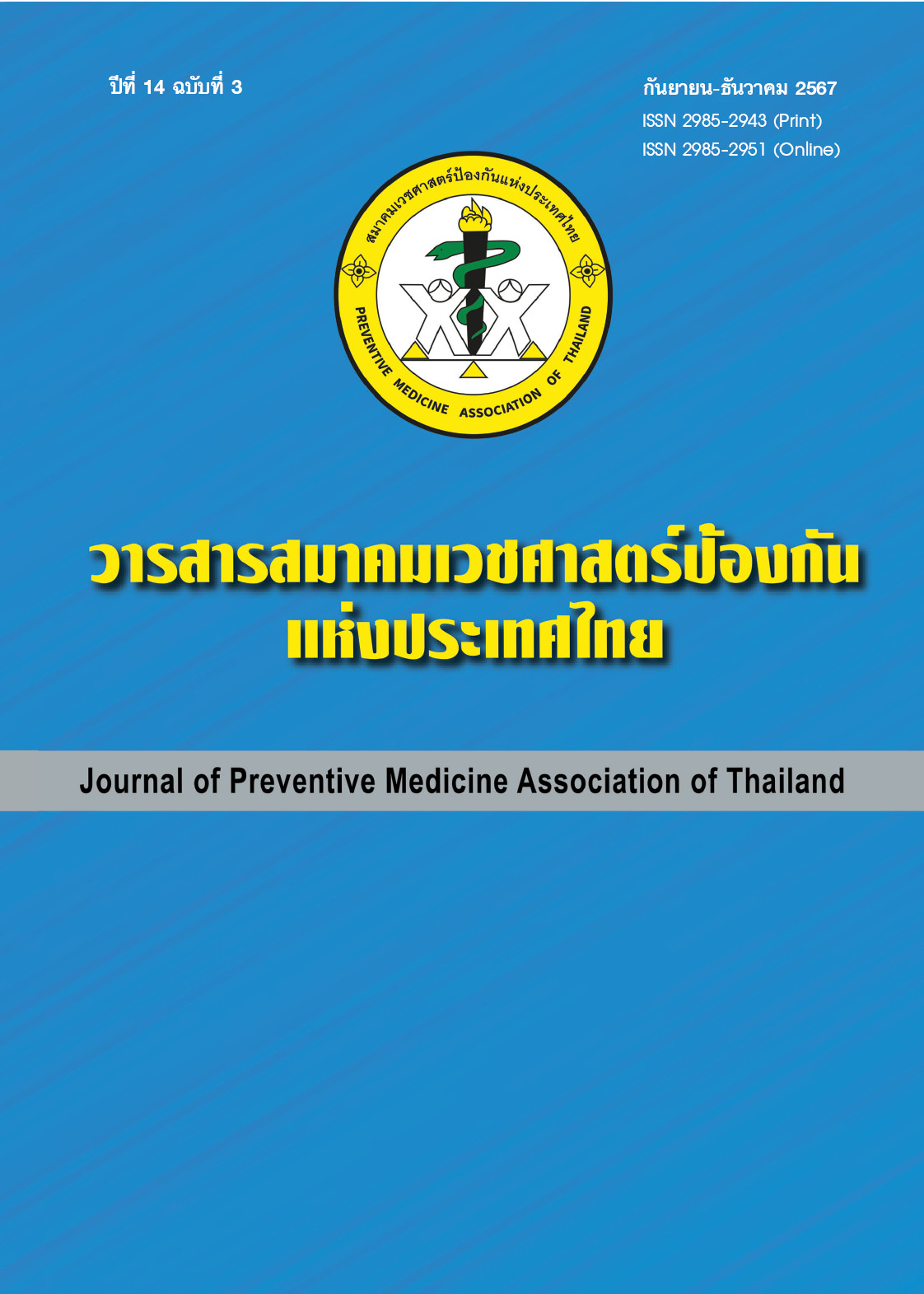การป้องกันการเสียชีวิตจากโรคหัวใจและหลอดเลือด: ความท้าทายในสภาพสังคมผู้สูงอายุในอนาคตอันใกล้ของประเทศไทย
คำสำคัญ:
โรคหัวใจและหลอดเลือด, สังคมผู้สูงอายุ, ภาวะไขมันในเลือดผิดปกติ, เวชศาสตร์ป้องกันคลินิกบทคัดย่อ
โรคหัวใจและหลอดเลือดยังคงเป็นปัญหาสาธารณสุขสำคัญทั่วโลกและในประเทศไทย โดยเป็นโรคที่มีอัตราการเสียชีวิตสูงที่สุด แม้ปัจจุบันจะมีความก้าวหน้าทางเทคโนโลยีการแพทย์ก็ตาม ขณะนี้ประเทศไทยเข้าสู่สังคมผู้สูงอายุ โดยคาดว่าประชากรร้อยละ 30 จะมีอายุเกิน 60 ปีในอีก 20 ปีข้างหน้า ส่งผลให้การจัดการโรคหัวใจและหลอดเลือดในผู้สูงอายุจึงเป็นเรื่องสำคัญอย่างเร่งด่วน การป้องกันโรคหัวใจและหลอดเลือดแบ่งได้เป็นการลดปัจจัยเสี่ยงที่ไม่สามารถเปลี่ยนแปลงได้ (อายุ เพศ พันธุกรรม) และปัจจัยเสี่ยงที่สามารถเปลี่ยนแปลงได้ (พฤติกรรมการใช้ชีวิต ปัจจัยทางเศรษฐกิจและสังคม) สำหรับผู้หญิงวัยหมดประจำเดือน ซึ่งมีการลดลงของระดับฮอร์โมนเอสโตรเจน พบว่ามีความชุกของภาวะไขมันในเลือดผิดปกติเพิ่มขึ้นและเพิ่มอัตราการตายด้วยโรคหัวใจและหลอดเลือดอย่างมาก แนวทางการรักษาปัจจุบันเน้นการป้องกันทั้งปฐมภูมิและทุติยภูมิผ่านการปรับเปลี่ยนพฤติกรรมและการใช้ยา การป้องกันโรคหัวใจและหลอดเลือดในสังคมผู้สูงอายุของประเทศไทยจำเป็นต้องใช้กลยุทธ์หลายด้าน รวมถึงการส่งเสริมสุขภาพ การพัฒนาระบบสุขภาพ และความร่วมมือจากทุกภาคส่วน การดูแลแบบองค์รวมที่ครอบคลุมการปรับเปลี่ยนพฤติกรรมและสุขภาพจิตเป็นสิ่งสำคัญ เวชศาสตร์ป้องกันคลินิกมุ่งเน้นการเพิ่มคุณภาพชีวิตและการมีสุขภาพดีในวัยชรา โดยการป้องกันย่อมดีกว่าการรักษาเมื่อสายไปแล้ว
เอกสารอ้างอิง
World Health Organization. Global health estimates 2019: deaths by cause, age, sex, by country and by region, 2000-2019. Geneva: World Health Organization; 2019.
Roth GA, Forouzanfar MH, Moran AE, Barber R, Nguyen G, Feigin VL, et al. Demographic and epidemiologic drivers of global cardiovascular mortality. N Engl J Med 2015;372(14):1333-41.
สำนักนโยบายและยุทธศาสตร์ กระทรวงสาธารณสุข. สถิติสาธารณสุข พ.ศ. 2562. นนทบุรี: กระทรวงสาธารณสุข; 2562.
สำนักงานสถิติแห่งชาติ. สภาวะประชากรสูงอายุในประเทศไทย พ.ศ. 2563. กรุงเทพฯ: สำนักงานสถิติแห่งชาติ; 2563.
Yusuf S, Hawken S, Ôunpuu S, Dans T, Avezum A, Lanas F, et al. Effect of potentially modifiable risk factors associated with myocardial infarction in 52 countries (the INTERHEART study): case-control study. Lancet 2004;364(9438):937-52.
Havranek EP, Mujahid MS, Barr DA, Blair IV, Cohen MS, Cruz-Flores S, et al. Social determinants of risk and outcomes for cardiovascular disease: a scientific statement from the American Heart Association. Circulation 2015;132(9):873-98.
World Health Organization. Preventing chronic diseases: a vital investment [Internet]. 2019 [cited 2019 Jun 20]. Available from: https://shorturl.asia/5RhNz
Pappan N, Rehman A. Dyslipidemia [Internet]. 2022 [cited 2019 Jun 20]. Available from: https://www.ncbi.nlm.nih.gov/books/NBK560891/
Xi Y, Niu L, Cao N, Bao H, Xu X, Zhu H, et al. Prevalence of dyslipidemia and associated risk factors among adults aged ≥35 years in northern China: a cross-sectional study. BMC Public Health 2020;20(1):1068.
Orekhov AN, Ivanova EA. Cellular models of atherosclerosis and their implication for testing natural substances with anti-atherosclerotic potential. Phytomedicine 2016;23(11):1190-7.
สมาคมโรคหลอดแดงแห่งประเทศไทย. แนวทางเวชปฏิบัติการใช้ยารักษาภาวะไขมันผิดปกติเพื่อป้องกันโรคหัวใจและหลอดเลือด พ.ศ. 2567. กรุงเทพฯ: สมาคมโรคหลอดแดงแห่งประเทศไทย; 2567.
Handelsman Y, Jellinger PS, Guerin CK, Bloomgarden ZT, Brinton EA, Budoff MJ, et al. Consensus statement by the American Association of Clinical Endocrinologists and American College of Endocrinology on the Management of Dyslipidemia and Prevention of Cardiovascular Disease Algorithm - 2020 Executive Summary. Endocr Pract 2020;26(10):1196-224.
Tangcharoensathien V, Witthayapipopsakul W, Viriyathorn S, Patcharanarumol W. Improving access to assistive technologies: challenges and solutions in low-and middle-income countries. WHO South-East Asia J Public Health 2018;7(2):84-9.
Huffman MD, Capewell S, Ning H, Shay CM, Ford ES, Lloyd-Jones DM. Cardiovascular health behavior and health factor changes (1988-2008) and projections to 2020: results from the National Health and Nutrition Examination Surveys. Circulation 2012;125(21):2595-602.
ดาวน์โหลด
เผยแพร่แล้ว
รูปแบบการอ้างอิง
ฉบับ
ประเภทบทความ
สัญญาอนุญาต
ลิขสิทธิ์ (c) 2024 สมาคมเวชศาสตร์ป้องกันแห่งประเทศไทย

อนุญาตภายใต้เงื่อนไข Creative Commons Attribution-NonCommercial-NoDerivatives 4.0 International License.
บทความที่ลงพิมพ์ในวารสารเวชศาสตร์ป้องกันแห่งประเทศไทย ถือเป็นผลงานวิชาการ งานวิจัย วิเคราะห์ วิจารณ์ ตลอดจนเป็นความเห็นส่วนตัวของผู้นิพนธ์ กองบรรณาธิการไม่จำเป็นต้องเห็นด้วยเสมอไป และผู้นิพนธ์จะต้องรับผิดชอบต่อบทความของตนเอง






